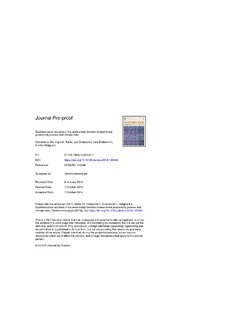| dc.contributor.author | Ols, Clémentine | |
| dc.contributor.author | Kålås, Ingvil Henden | |
| dc.contributor.author | Drobyshev, Igor | |
| dc.contributor.author | Söderström, Lars | |
| dc.contributor.author | Hofgaard, Annika | |
| dc.coverage.spatial | Noreg, Norge, Norway | nb_NO |
| dc.date.accessioned | 2019-11-15T12:10:40Z | |
| dc.date.available | 2019-11-15T12:10:40Z | |
| dc.date.issued | 2019 | |
| dc.identifier.issn | 1125-7865 | |
| dc.identifier.uri | http://hdl.handle.net/11250/2628742 | |
| dc.description.abstract | The impacts of climate change on high-latitude forest ecosystems are still uncertain. Divergent forest productivity trends have recently been reported both at the local and regional level challenging the projections of boreal tree growth dynamics. The present study investigated (i) the responses of different forest productivity proxies to monthly climate (temperature and precipitation) through space and time; and (ii) the local coherency between these proxies through time at four high-latitude boreal Scots pine sites (coastal and inland) in Norway. Forest productivity proxies consisted of two proxies representing stem growth dynamics (radial and height growth) and one proxy representing canopy dynamics (cumulative May-to-September Normalized Difference Vegetation Index (NDVI)). Between-proxy and climate-proxy correlations were computed over the 1982-2011 period and over two 15-yr sub-periods. Over the entire period, radial growth significantly correlated with current year July temperature, and height growth and cumulative NDVI significantly correlated with previous and current growing season temperatures. Significant climate responses were quite similar across sites, despite some higher sensitivity to non-growing season climate at inland sites. Significant climate-proxy correlations identified over the entire period were temporarily unstable. Local coherency between proxies was generally insignificant. The spatiotemporal instability in climate-proxy correlations observed for all proxies underlines evolving responses to climate and challenges the modelling of forest productivity. The general lack of local coherency between proxies at our four study sites suggests that forest productivity estimations based on a single proxy should be considered with great caution. The combined use of different forest growth metrics may help circumvent uncertainties in capturing responses of forest productivity to climate variability and improve estimations of carbon sequestration by forest ecosystems. | nb_NO |
| dc.language.iso | eng | nb_NO |
| dc.subject | Dendroclimatology | nb_NO |
| dc.subject | Remote sensing | nb_NO |
| dc.subject | Carbon sequestration | nb_NO |
| dc.subject | Boreal ecosystems | nb_NO |
| dc.subject | Vegetation productivity | nb_NO |
| dc.subject | Arctic amplification | nb_NO |
| dc.title | Spatiotemporal variation in the relationship between boreal forest productivity proxies and climate data | nb_NO |
| dc.type | Peer reviewed | nb_NO |
| dc.type | Journal article | |
| dc.description.version | acceptedVersion | nb_NO |
| dc.rights.holder | © 2019 Elsevier | nb_NO |
| dc.subject.nsi | VDP::Matematikk og Naturvitenskap: 400::Zoologiske og botaniske fag: 480 | nb_NO |
| dc.source.journal | Dendrohcronologia | nb_NO |
| dc.identifier.doi | 10.1016/j.dendro.2019.125648 | |
| dc.identifier.cristin | 1748040 | |
